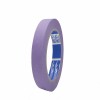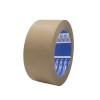The most effective techniques to remove paper tape glue
How to remove paper tape glue? This is a fairly common question, due to the simple fact that the employment of double-sided paper tapes is extremely widespread, for the most diverse uses.
Consider painters, who use industrial double-sided paper to protect baseboards, doors, windows, shelves and other furniture, or to create combinations of different colours.
Or body shop mechanics, who use industrial double-sided adhesive paper tape both for sandblasting and for painting, to avoid leaving smudges. Moreover, paper tape is also used for different needs, including masking, hanging posters, sealing packages, placing cables, creating bundles, and so on.
But how can you remove paper tape glue once you want to remove the tape?
The characteristics of paper tape
Paper tape, which was created as a tool for masking, is designed precisely to ensure a convenient and fast removal at the end of the work, without leaving any glue residue behind.
In more detail, after having coloured a wall or after painting another type of surface, it is always recommended you remove the masking paper tape before the colour dries, shortly after finishing the work.
This way you can remove the tape without the risk of “taking away” even some small piece of colour now dry and “glued” to strong double-sided adhesive tape – although it should be noted that the best paper masking tapes are manufactured to minimize this possibility.
The best way to remove the paper tape after colouring a surface is to proceed slowly, without tearing, taking care to form an angle between 45 and 90 degrees between the paper surface of the tape and the coloured one: this way, you can be sure to remove the tape without smudging and without ruining the colour.
That said, we must reiterate: normal use of paper tape does not usually result, once the double-sided adhesive tape is removed, in residual glue remaining on the underlying surface. However, in certain cases this may still happen.
For example, this is the case with paper tape that, instead of being removed within a short time, remains glued somewhere– for example to a wooden surface – for months or even years.
Perhaps, during that time, the surface may have been subjected to high temperatures, or frequent exposure to sunlight. In these rather rare cases, you exceptionally might have to deal with glue residue firmly attached to the surface after removing the paper tape: let’s have a look at how to remove that paper tape glue.
How to remove paper tape glue?
The first technique to remove paper tape glue, whether the residue is on a wall or on another kind of surface, you should always try to use hot air first.
It is, in fact, a rather effective technique, that everyone can put into practice, and that does not involve any type of risk for the surface in question.
The tool to use is obviously the hair dryer, which could also be used as preventive method, to heat the paper tape before attempting removal, so as to reduce the amount of residue that will remain on the surface below.
However, to remove paper tape glue with heat, you will have to direct the hot air jet to the affected area and hold for about twenty seconds. Then you can proceed with the mechanical removal of glue residue.
The most effective way is to arm yourself with a scraper which can allow you to remove the glue without scratching or damaging the surface: plastic scrapers used regularly in winter to remove ice from cars’ windshields are excellent for this purpose. Old plastic cards can also be useful.
Scrapers of this type are very useful on smooth and resistant surfaces such as sanded and/or painted wood, glass, plastic, metal, and so on. A plastic scraper could instead leave some lines on plastered walls: it is therefore better to opt for a softer plastic card, or a clean cloth.
Where there is no heat, it is possible to work with water mixed with a few drops of vinegar, a solution that can also be tried on porous surfaces such as plaster and unpainted wood, with just a little liquid.
On other non-porous surfaces, you can also try vegetable oil, which will help to make the glue residue “slide off”. In the case of particularly stubborn residue, you can also help yourself using tweezers.







